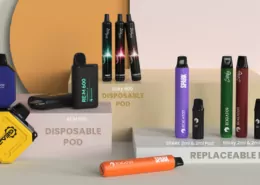GSTHR Report Finds Vapes Help Smokers Quit in New Zealand
GSTHR Briefing Paper Showcases Aotearoa New Zealand’s Smoking Cessation Success Through Vaping
The Global State of Tobacco Harm Reduction (GSTHR), a project from public health agency Knowledge·Action·Change (KAC), has released its latest Briefing Paper, which sheds light on Aotearoa New Zealand’s remarkable journey towards achieving “smokefree” status. The report, titled “Pro-consumer laws and an endorsement for vaping: why smoking is disappearing in Aotearoa New Zealand,” showcases the country’s rapid embrace of vaping as a critical tool in reducing smoking rates and provides valuable insights for other countries seeking to tackle the global smoking epidemic.
Aotearoa New Zealand’s Rapid Decline in Smoking Rates
Aotearoa New Zealand has experienced a significant decline in smoking rates over the past 50 years, with a notable acceleration following the widespread adoption and legalization of nicotine vaping products in 2018. Thanks to the government’s proactive approach to vaping policy, the country now has a considerable chance of reaching its “Smokefree 2025” goal, which aims to reduce smoking prevalence to below 5%.
David MacKintosh, a director for KAC, emphasized the importance of the Briefing Paper in exploring Aotearoa New Zealand’s progress in reducing smoking, the strategies employed, and the lessons that can be learned by other countries. “By embracing vaping as a tool for smoking cessation, policymakers are accelerating the transition away from cigarettes and their associated harms,” he stated.

Aotearoa New Zealand’s smoking rate has fallen dramatically from 40% for men and 32% for women in 1976 to just 8.3% of adults in 2023. In the same year, 11.9% of adults vaped, marking a significant increase from 1.4% in 2016. This shift highlights the growing acceptance and effectiveness of vaping as a safer alternative to traditional cigarettes.
However, the report also notes that while overall smoking figures are low, they mask much higher rates within some communities, particularly among Māori, who make up 16% of the country’s population. In 2022/2023, the daily smoking prevalence for Māori was 17.1%, in stark contrast to the 6.1% rate for people of European descent, highlighting the need for targeted interventions to address health disparities.
A key factor in Aotearoa New Zealand’s success has been the proactive encouragement of vaping as a smoking cessation tool by the government. The Ministry of Health has provided official resources for people looking to quit smoking with the help of vaping, and Smokefree New Zealand, a publicly funded smoking cessation resource, has stated that “using vaping products is a legitimate option for those people who are trying to quit smoking.”
Through the Vaping Facts website, the Ministry of Health of New Zealand and Health New Zealand have also emphasized the Cochrane Review’s position that vaping is significantly safer than smoking. This supportive public health messaging has enabled consumers to make informed decisions and switch from smoking to safer products.
Aotearoa New Zealand vs. Australia
Aotearoa New Zealand’s attitude towards vaping stands in direct contrast to its neighbor, Australia, which has heavily restricted the availability of safer nicotine products (SNP) by making nicotine available only in pharmacies. Australia’s approach has led to the proliferation of a thriving black market in the absence of a legal market, while Aotearoa New Zealand’s broadly supportive public health messaging has empowered consumers to make positive changes on their own volition.
The differences in approach have resulted in a marked difference in smoking rates between the two countries, with Australia’s smoking prevalence plateauing in recent years after many years of steady decline. In the last five years, the current smoking prevalence for Australians aged 14 and over has only fallen slightly, from 12.8% in 2018 to 11.8% in 2023.
Lessons Learned and Future Challenges
While Aotearoa New Zealand’s attitude towards vaping is not mirrored for all SNP, with the sale of both snus and nicotine pouches being banned, the country has demonstrated its ability to enact pro-consumer legislation effectively. The consistent endorsement of some safer nicotine products has been a key component of its stop-smoking strategy, with consumers playing a central role in establishing demand for safer products and proving to the government that these products can and will exist despite initial legislative opposition.
As Aotearoa New Zealand continues its journey towards a “smokefree” future, addressing the higher smoking rates among Māori communities remains a critical challenge. Targeted interventions and culturally sensitive approaches will be essential in reducing health disparities and ensuring that the benefits of tobacco harm reduction reach all segments of the population.
The GSTHR Briefing Paper serves as a valuable case study for other countries seeking to reduce smoking rates and improve public health outcomes. By embracing vaping as a legitimate tool for smoking cessation, enacting pro-consumer legislation, and providing supportive public health messaging, Aotearoa New Zealand has demonstrated the potential of tobacco harm reduction through the adoption of safer nicotine products.
- Foger Bit 35K Disposable Vape Review – Crypto Style Vaping - August 16, 2025
- Cambodia: Phnom Penh Bans Smoking & Vaping on “Walk Street” - August 16, 2025
- Mexico City Congress Approves Ban on Vapes & E-Cigs - August 16, 2025









